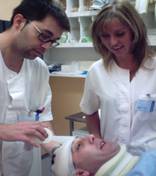
Health sciences have a long tradition in the practical use of peer learning or learning among colleagues, having doctors learn from more expert doctors, or nurses learn from their colleagues. The practice of cure is ontologically similar to educational practice. Although both types of practice aim at different objectives they have in common the fact that they are activities where a high level of uncertainty, ambiguity and openness. Moreover, they are regulated by ethic norms and develop through deliberation processes involving meaning understanding and construction among participants (teachers/students; nurses/taken-care-of people)
Cure can be considered a typical form of interpersonal praxis where professionals daily confront problematic situations they need to solve, where their colleague’s help and opinion, beside being highly valuable, is completely necessary. Such help can come mostly through one-to-one interaction or in groups. Most of the nursing activity develops within a context of multidisciplinary work where coordination becomes essential to guarantee the quality in catering for health.
Nursing professionals learn from interaction with other colleagues, and the collaboration among them becomes an essential tool to help reflective practice, a key resource to attain maximum professional efficacy and the permanent improvement of nursing practice. This will positively revert in the subjects they attend to (students or patients).
Nurses working together have the opportunity to share their experience, associating meaning, working on concept and principle abstraction, and transforming their practical activity. It is in this context where socialization and professional values internalization take place. Collaboration among professionals results in more positive and mutually binding relationships. This produces an increased commitment to obtain the patient’s wellbeing. The technical and emotional support offered by collaborative interaction allows for ensured and more quality cures which adapt to the real needs of the taken-care-of people. Patients, families and the community receive the benefits of this type of interaction since they are attended to by professionals with a higher self-steem who are thus more motivated for cure.
However, collaborative work does not automatically result when placing two colleagues together. It is very important not to consider collaborative work as a working scheme where “everyone does everything”. Collaborative interaction needs individual contribution to be well defined and each professional must be clear as to which responsibility s/he needs to accept and the objectives s/he needs to fulfill. A disposition for commitment and respect as regards the colleague or group in which one interacts is necessary.